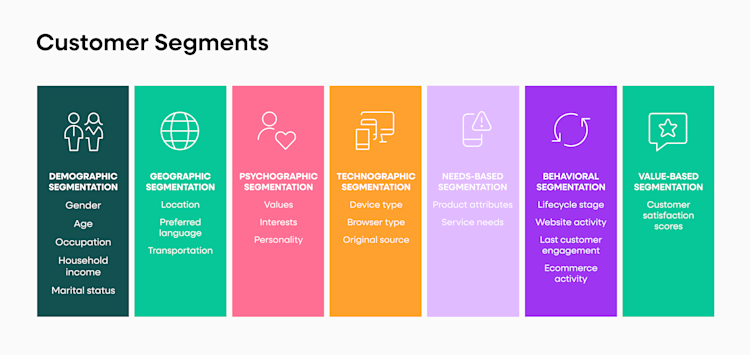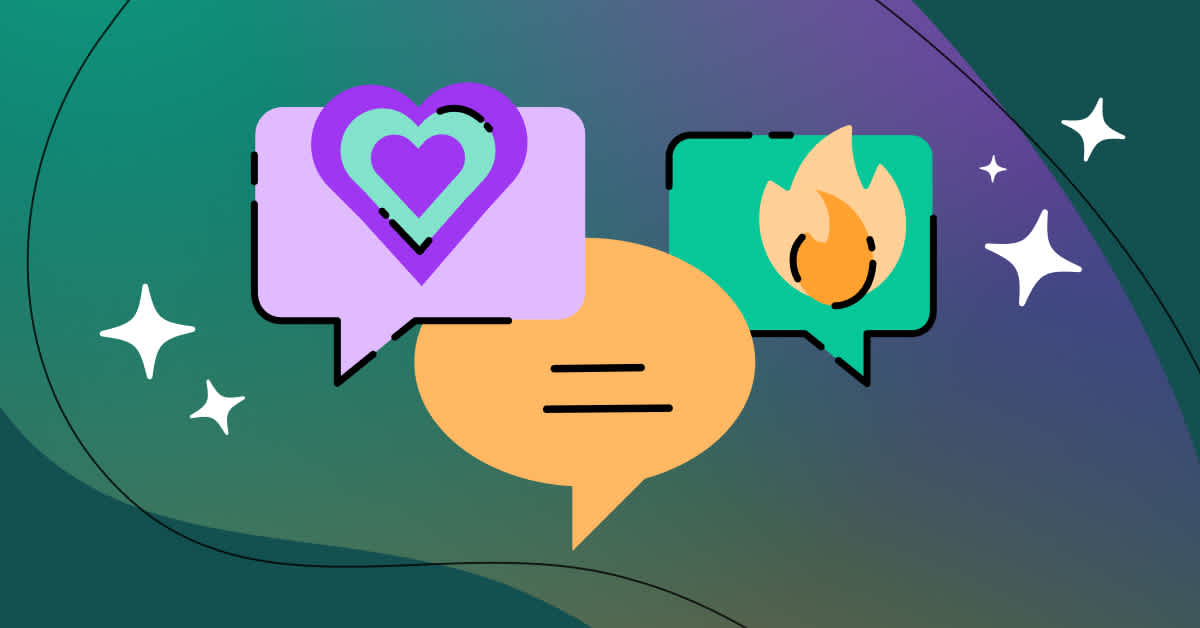Think about your marketing strategy. The idea of treating every customer the same might seem a bit outdated, right? And it should for good reason.
Every customer has their own unique needs, preferences, and behaviors. Customer segmentation helps you understand and capitalize on your customer base. Grouping customers into categories allows you to customize your approach, improve customer experience, and drive growth.
Customer segmentation eliminates the one-size-fits-all targeting approach, allowing brands to focus on the needs of their customers.
Customer segmentation analysis is the practice of dividing customers into groups based on common traits to tailor marketing efforts, ensuring more targeted and effective campaigns.
There are 8 main models of customer segmentation: demographic, geographic, psychographic, technographic, needs-based, behavioral, value-based, and firmographic.
What is customer segmentation?
Customer segmentation is the strategic process of categorizing a company's customers into distinct groups based on shared characteristics, behaviors, or preferences. It enables businesses to personalize campaigns to more effectively meet the unique needs and maximize the value of each customer group.
Think of it as tailoring your approach to fit various groups like a glove, making sure that your marketing hits the right note every time.
Why should you segment customers?
Segmenting your customer base is a strategic approach to hone your marketing efforts. Identifying customer segments allows you to:
1. Personalize your marketing campaigns
Think of your marketing as speaking directly to the needs and desires of every customer. When you segment your audience, you're able to customize communication that resonates with your target audience.
It not only grabs their attention but also significantly improves your conversion rates. And personalization goes beyond addressing customers by name; it's about tailoring content, offers, and engagement to individual preferences and behaviors.
2. Boost customer loyalty and retention
Customers like to stick with brands that show they actually understand them. Segmentation allows you to nurture your existing customers with relevant communication, reinforcing their decision to remain loyal to your brand.
3. Better understand your customers' needs
You can also gather lots of detailed insights into your customers' needs and preferences. Use customer feedback and purchase history to tailor your products and services more effectively.
Understanding the nuances of your customer experience can lead to improved products, services, and support that speak directly to happier customers.
Types of customer segmentation models
Now that we've got an idea of how to segment customers based on their almost infinite characteristics, it's time we discuss what types of things we'll group them by.
Each model below offers a unique lens through which you can understand and engage with your customers.
Demographic segmentation
Demographic segmentation is about the "who" of your customer base. This tried-and-true approach is a starting point for personalizing your marketing efforts.
Examples of demographic segmentation include:
Age
It’s also possible to explore differences in age when segmenting customers. Older generations often have different needs and preferences than younger ones, so it’s important that you don’t overlook this factor when segmenting your customers.
Occupation
The occupation of your customers can say a lot about their interests, availability, and budget. This is especially true if they don’t share these details with you directly—which can be particularly useful if you are trying to target them with specific offers or services.
Household income
Household income is an important factor to consider when segmenting customers, as it’s a strong indicator of how much money they have available to spend with your business. It can also provide insight into what type of products or services would be most appealing to them and their wallet.
Marital status
If marriage status is another data point that you are interested in, it can be segmented into a few different categories, such as if there is a spouse or their relationship status, among others.
Understanding this information can give you some extra insight into the type of lifestyle your customers lead and what types of products or services may be most useful to them.
Gender
For a fast overview of your customer base, you could start by looking at the gender of your customers. However, it’s important to ensure that this segmentation is inclusive and that there are plenty of categories to choose from so everyone can be comfortably sorted into their own group.
Geographic segmentation
Where your customers live can significantly influence their buying habits. Geographic segmentation looks at location factors that allow businesses to adapt their products and services to fit the nuances of local markets.
Examples of geographic segmentation include:
Location
Where your customers live can be a great indicator of how you should approach targeting them. People in different regions may have different cultural influences or even different preferences for products and services. By taking advantage of this information, you can create more personalized marketing strategies that are tailored to specific locations.
Preferred language
If you’re marketing to a global audience, understanding the preferred language of your customers can be extremely helpful. This way, you can make sure your messaging is tailored in such a way that resonates with them and feels more “local”.
Transportation
What’s the primary method your customers use to get around? If your customer base frequently uses public transportation, you can use this information to create targeted campaigns. This could include buying ad space on popular train routes or digital billboards throughout the city.
Psychographic segmentation
Digging into your customers' interests, personality traits, and lifestyles, psychographic segmentation divides the market based on psychological attributes.
Examples of psychographic segmentation include:
Values
Customer values are at the heart of psychographic segmentation and understanding your customer’s values can be an effective way to create a connection with them.
By using one-on-one interviews and surveys, you can get a good idea of what matters most to your target audience. This could range from environmental conservation to affordability and convenience—all of which will help guide your product or service design.
Interests
Every business benefits from knowledge of their customer’s interests. Knowing what your customers are passionate about can give you great insight into how to capture their attention and loyalty.
Interests are things that customers enjoy that might not directly relate to your business, but could be connected in other ways.
Identity traits
Identity is another great way to understand your customers better. Each person has their own unique personality and identity, and understanding this can be incredibly valuable when it comes to creating a connection with the customer base.
Through surveys, interviews, and observation, you can learn more about how different people interact with your brand and how you can best meet their needs.
Technographic segmentation
With technographic segmentation, you're considering the devices and apps your customers use.
Examples of technographic segmentation include:
Device type
An overwhelming sector of online traffic comes from mobile devices, so it’s important to consider the device type when segmenting your customers.
For example, if most users are interacting with you via smartphones, then you know to prioritize mobile responsiveness. You might even consider building a mobile app tailored toward these customers.
Browser type
It’s not just the device type you should consider when segmenting customers. You want to also think about what browser they are using. Different browsers might present your site or app differently, causing different behavior.
Original source
Original source refers to the initial starting point of your customer base. If you’re able to pinpoint where your customers are coming from, you can start creating content and marketing strategies tailored to them.
Needs-based segmentation
Here, you classify customers by their specific needs or service needs. This model is about addressing the pain points directly and offering solutions that feel tailor-made.
For example, a company selling office software could segment its customers by those needing project management support versus those looking for efficient communication tools.
Other examples of needs-based segmentation include:
Product attributes
When segmenting customers, think about their product needs and attributes. For example, you might have products that require certain features to be used correctly. By knowing who typically has these needs, you can create content tailored to those groups—making sure your website is as inclusive as possible.
Service needs
In addition to your products, you should also think about the services your customers need, too. Services can range from technical support to customer service inquiries, from checking out a product to applying for a loan.
Knowing what your customers are typically looking for gives you an idea of what kind of services to prioritize and which ones might not be as important.
Behavioral segmentation
Behavioral segmentation zooms in on how customers interact with your brand. It examines behaviors, usage patterns, and buyer personas to anticipate needs and craft targeted messaging. Whether your customers are frequent buyers or occasional shoppers will dictate different engagement strategies.
Examples of behavioral segmentation include:
Lifecycle stage
The lifecycle stage can be a very useful way to segment your customers. This tool helps you understand where a customer is in the customer-buying experience. New customers are usually just getting started, so you have to focus on the basics.
Loyal customers, however, are more likely to be advocates for your brand. Thus, it’s important to focus on creating content that rewards their loyalty and encourages them to spread the word about your business.
Website activity
Another way to segment your customers is through website activity. This metric tracks anything they do while engaging with your website, such as the pages they visit, how long they stay on each page, and what products or services they purchase.
Last engagement
The last engagement you have with customers can tell you a lot. If it was a positive interaction, they might be ready for an upsell or cross-sell. If the conversation wasn’t so great, then strengthening that relationship should be your priority.
Ecommerce activity
Ecommerce activity can provide key insights into what customers are looking for and how they interact with your online store. By tracking their past purchases as well as products they’ve viewed but not yet converted on, you can gain valuable insight into the types of products or services they might be interested in.
Example
A good example of this is Amazon. They track customer purchases and browsing habits to make product recommendations tailored to each individual customer. This helps them build better relationships with existing customers and attract new ones.
Value-based segmentation
Values-based segmentation considers the values, ethics, and social responsibility significant to your customers. It’s essential for brands aiming to connect on a deeper, more emotional level, such as companies emphasizing sustainability and ethical sourcing in their marketing.
Examples of value-based segmentation include:
Customer satisfaction scores
Thanks to the many ways customers rate their experiences, it’s easy to keep track of customer satisfaction scores (for example, NPS). This can help you determine how customers feel about your offerings and if they’re truly satisfied.
If scores are high, that’s a sign that you’re on the right track with your services. On the other hand, lower scores are an indication that changes need to be made.
Customer feedback isn’t limited to only quantitative scoring. Open-ended questions that customers can use to provide in-depth feedback is invaluable qualitative data.
Firmographic
Lastly, and similar to individual demographics, firmographic segmentation caters to B2B markets. It groups companies by industries, company size, and other organizational characteristics. For example, a tech startup might have different service needs than a well-established manufacturing firm.
Examples of firmographic segmentation include:
Industry
The industry a business operates in can include sectors like technology, healthcare, finance, education, manufacturing, and more. Segmenting by industry allows businesses to tailor content and communication to the specific challenges, needs, and language of each sector.
Company size
Company size divides businesses based on the scale of their operations, typically measured by the number of employees or total number of offices/locations. This segmentation can range from small and medium-sized businesses (SMBs) to large enterprises.
Understanding a company's size helps in customizing product offerings, communication, and support services to match the operational capacity and needs of potential clients.
Annual revenue
Annual revenue segmentation categorizes companies by their yearly income. This financial metric is a direct indicator of a company's market footprint and purchasing power.
Segmenting businesses by annual revenue allows for customized pricing strategies, product packages, and sales approaches that align with the financial capabilities and priorities of each revenue bracket.
What is customer segmentation analysis?
Imagine a busy farmer's market. Each stand is brimming with vivid fruits, each appealing to different people. Customer segmentation analysis is about identifying which groups of people are drawn to which fruit stand and why.
Groups can range from demographics like age and gender to more nuanced traits like shopping patterns or fruit preferences in this case.
Now that you're familiar with different customer segments, the goal of segmentation is to understand that you're not just broadcasting a one-size-fits-all message. You're engaging in a customized dialogue with distinct messages that resonate with your segments.
How do you segment your customers?
Want to know which models are most suitable for your business? It depends on your particular needs and objectives.
Let's break down how you can start identifying customer segments.
1. Set goals and identify variables
As with any new project, you must define your goal with segmentation. Are you looking to enhance communication, pinpoint opportunities for innovation, or increase customer retention?
Then, identify the variables that matter most to you and your company, including demographic, geographic, behavioral, or psychographic traits.
For example, if you’re running a loyalty program, then it’s probably wise to choose an RFM (recency, frequency, and monetary value) model.
2. Collect and analyze customer experience data
Gathering data is crucial. Begin by asking yourself what kind of customer data set impacts conversions, such as demographics, psychographics, behaviors, attitudes, values, lifestyle preferences, etc.
Use resources like your existing CRM tool to pull historical data and look for trends. Surveys and feedback can also provide deeper insights into your customers.
Once you’ve identified this data, use it to fill in the gaps between the data you already have and the data you need to improve your customer segmentation strategy.
3. Segment customers
With your data in hand, create your customer segments. Put together categories based on your patterns, defining groups by things like their purchasing behavior or how they interact with your brand online.
Tools like Google Analytics can help you collect a wide range of demographic data on your customers and learn how people are engaging with your website, while Fullstory can go a step deeper and surface user sentiment through behavioral data.
4. Implement your findings
Now, put your segmentation strategy into action within your campaigns. Adjust your marketing strategy to communicate effectively with each segment and keep the message relevant. Analyze how your new customized experiences impact customer interactions and overall growth performance.
5. Repeat the process
Customer segmentation isn't a one-time task, so expect to update your segments with fresh customer experience data regularly. Your primary goal is long-term engagement and campaign innovation based on your customers' evolving needs.
Understand customer lifetime value (CLV)
Understanding Customer Lifetime Value (CLV) offers vital insights into the sustainable growth of your business. It’s about recognizing how much profit a customer brings to your organization from their initial purchase to their final transaction with your company.
So why is CLV so important?
Long-term profitability: Recognizing the total revenue you can expect from a single customer illuminates the long-term profitability of your customer relationships.
Strategic decision-making: Knowing the CLV guides you in making informed decisions on customer acquisition costs and retention strategies.
Remember, the goal isn’t just to sell, but to nurture a loyal customer base that believes in your brand’s value. To achieve this, focus on building strong relationships through excellent customer service and by delivering consistent value.
Personalized experiences = a more engaged audience.
Whether you employ segmentation manually or through customer segmentation software, it is an invaluable tool for understanding your audience.
Breaking customers into smaller segments can help you get a better glimpse of who they are and what they want from your product.




